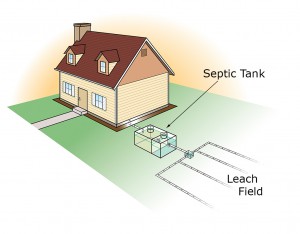What is a septic system and what can go wrong?
A septic system is a natural, self contained, underground system for treating wastewater onsite. A septic system is often more feasible and/or economical than a connection to a public sewer system, especially in rural areas. In North America approximately 25% of the population relies on septic systems.
Here’s how septic systems work:
Waste water flows from a house or building to a tank, usually made of concrete or fiberglass, where several things occur:

- Waste flows into and is held in a double cell tank.
- Solids, liquids, and lighter than water oil and grease separate into layers.
- Anaerobic bacteria breaks down the solids.
The solids and scum that cannot be broken down by the bacteria are retained in the tank. Periodically the solids retained in the tank must be pumped out.
The liquid waste moves from the tank to a drain field (leach field) which is an absorption system, usually made of trenches containing perforated pipes in a gravel bed. The gravel and soil act as natural biological filters to remove particles and allow the remaining water soak into the ground.
That’s the simple explanation. There are a few things to remember. A septic system will be affected by several factors:
- The number of people in a household.
- The amount of waste introduced into the system (based on the number of people and the amount of water used).
- The amount of solids placed into the system (for instance, using a kitchen garbage disposal will increase the amount of solids).
What can go wrong?
A common problem is forgetting to have the solids removed (tank pumped) every 3 to 6 years. When they are not removed the tank begins to fill up. A tank is sized to give time for the solids and oils to separate from the water. With less time being available for settling, solids and oils can pass into the second chamber of the tank. As they fill up the second chamber they eventually flow into the leach field. There they begin to seal up the leach field.
As gravity pulls fluids down into the soil it is the bottom of the field that seals up first. The result is septic fluids (black water) eventually flow up to the surface. This present a serious health problem.
Breaks & Leaks
Also… over time, tanks can settle and break or break piping. The effects of age on materials used in construction of the septic system may cause leaks, allowing solids to escape and reduce the ability of the soil to absorb fluids.
Natural Problems
The nature of the soil and rock in the area can have a major impact on the effectiveness and life of a septic system. Trees and other plants can grow into the leach field pipes reducing capacity.
Design, Construction, & Size Problems
Sometimes, a system was not properly designed and/or set up from the beginning. As a new family grows a system may seem to work as the sewage load is less. As the family grows the system needs to work at design capacity. A poorly designed or built system may not. Or a home may be enlarged and the septic system forgotten.
Note: If you are buying a home relying on a septic system, we can test the system.
When to worry…
If you think you are experiencing symptoms of failure or inefficiency in your septic system, don’t wait. Call a qualified professional to diagnose the situation for you. American Construction & Septic will be able to help you understand what may be going wrong with your system and what can be done about it.
Call us at 619.520.2041 or send us a message from the Contacts page.